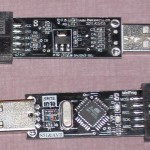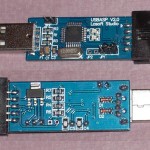Hardware
The USBasp hardware is the standard for 10Pin. The low cost, simple design, availability, low cost,
and software support drive this decision. Though you can recreate this hardware based upon the
available USBasp schematics, it is expected that instead you will re-purpose hardware sold as a
USBasp programmer.
As USBasp is an open hardware/software design it is not surprising that it is widely cloned/
copied by the Chinese electronics machine. The downside is that there are many variations of
the hardware and they may not be 100% compatible. Part of the fun of 10Pin will be identifying
suitable hardware and documenting differences and modifying the code to suit the hardware.
In general the available hardware includes an Atmega8 processor clocked at 12MHZ. As a general
Atmega8 development board they are lacking breakouts for all of the available GPIO pins. This is
probably the major limitation with the USBasp hardware in regards to being a useful development
platform. This still allows many projects with minimal GPIO requirements to be created with a low
hardware cost.
Following are details on two variations of 10Pin hardware that we have researched.
BeteMCU – MiniProg
Pros:
- Hardware compatible with USBasp software. Uses same USB, LEDs, and ISP port mappings.
- ISP Pins are labeled.
- Has onboard 3V voltage regulator (see note below).
Cons:
- Does not include J3 header (preferred for USBaspLoader use).
- 3V voltage regulator is not easily selectable (must solder the board).
- Voltage to ISP connector is not easy to disable.
Note: LEDs are red and yellow, instead of red and green as per USPasp hardware design.
Lcsoft Studio
10pin – Lcsoft Studio Reference Page
Pros:
- Hardware compatible with USBasp software. Uses same USB, LEDs, and ISP port mappings.
- ISP connector has TX/RX serial pins (included in USPasp design, but not used by USBasp software).
- Includes holes for J3 header. This is the preferred way to initiate the USBaspLoader boot loader.
- On board 3V voltage regulator is easily selectable by jumpers.
- Voltage to ISP connector is easy to disable via jumpers.
Cons:
- ISP pins are not labeled.
- On board LEDs are both red and placed close together, making it hard to distinguish between them and reducing usefulness.
These devices are readily available on eBay for less than $10 shipped from China. Review the pictures carefully and ask the seller questions to confirm you get what you want. Ordering from China does have some risk and shipping is slow, but the low price and sense of adventure makes it worthwhile. Note according to some anecdotes from some random internet site (like this one), sometimes the components provided are not always consistent even for the same “brand” of device. Your mileage may vary.



0 Comments.